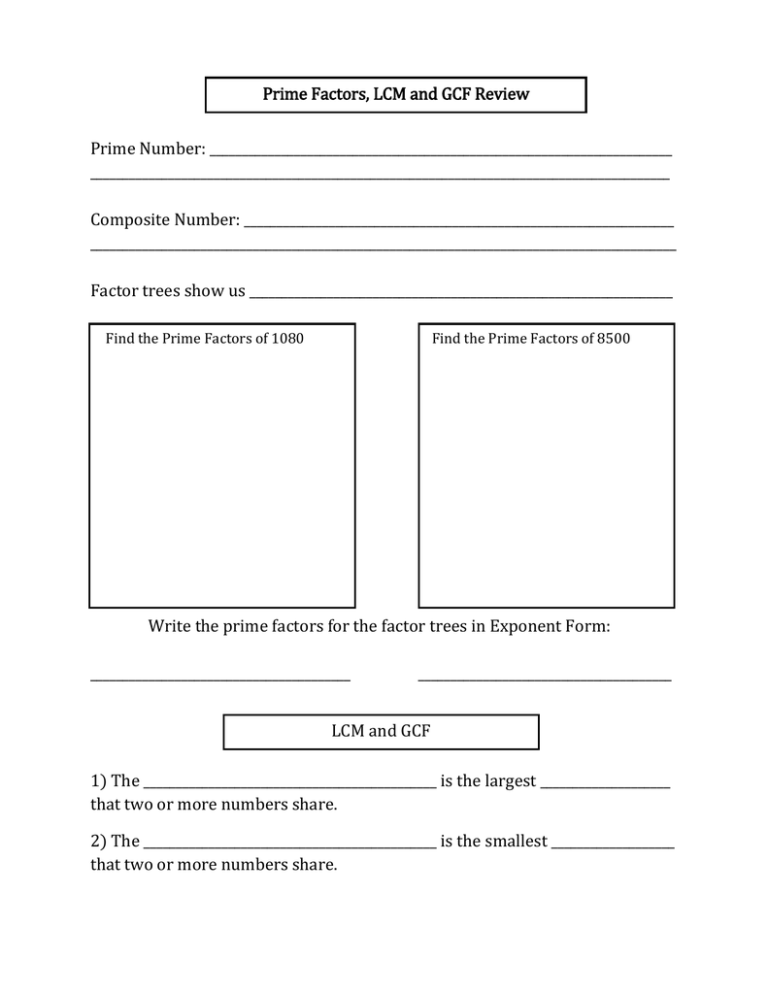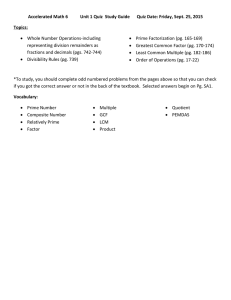Prime Factors, GCF, LCM Review Notes
advertisement

Prime Factors, LCM and GCF Review Prime Number: _______________________________________________________________________ _________________________________________________________________________________________ Composite Number: __________________________________________________________________ __________________________________________________________________________________________ Factor trees show us _________________________________________________________________ Find the Prime Factors of 1080 Find the Prime Factors of 8500 Write the prime factors for the factor trees in Exponent Form: ________________________________________ _______________________________________ LCM and GCF 1) The _____________________________________________ is the largest ____________________ that two or more numbers share. 2) The _____________________________________________ is the smallest ___________________ that two or more numbers share. - Greatest Common Factor – The product of all of the prime factors that the numbers have in common will tell us their GCF. - Least Common Multiple Each prime factor is multiplied by the number of times it is a factor in the factor tree it appears the most. Note: There are other ways of finding the GCF and LCM. The method you use is up to you. Refer to your class notes to see the other methods. Find the GCF of 210 and 252 Find the LCM of 60 and 54 Find the GCF of 270 and 198 Find the LCM of 315 and 420 Simplifying Fractions Using the GCF -A fraction is fully simplified when there are no common ____________________ in the numerator and denominator. -The greatest common factor of the numerator and denominator tells us the _____________________ of all the common factors. -We can ____________________ both the numerator and denominator by the GCF to find a fully simplified fraction. Examples Fully simplify the fractions given below: 120 420 1260 2625 Adding or Subtracting Fractions Using the LCM -To add or subtract fractions, the denominators must be ________________________. -The least common multiple will tell us the smallest number we can multiply both denominators by to get a common number. -Multiply the numerator by the same number as the denominator. 13 5 65 7 4 28 65 28 93 Ex: The LCM of 12 and 15 is 60, so + . 60 60 12 5 60 15 4 60 Examples Add/subtract the fractions given below: 10 21 27 45 161 97 168 100 Word Problems Involving GCF and LCM 1) Use the GCF for word problems that: a) ________________________________________________________________________________ b)_______________________________________________________________________________ Ex: There are 85 snickers bars and 51 lollipops. What is the largest number of treat bags that can be made if the snickers and lollipops are divided equally? 2) Use the LCM for word problems that: a)________________________________________________________________________________ b)________________________________________________________________________________ c)_______________________________________________________________________________ Ex: What is the smallest square pizza we can make if the pizza must be cut into 10cm x 12cm rectangular pieces without any leftover parts? Using Prime Factors to Identify Perfect Squares and Cubes 1) If the prime factors of a number can be divided into ________ _______________ groups, then the number is a perfect _____________________. The square ____________ of the number is _________ of the groups of prime factors. Ex: Is 1156 a perfect square? What is its square root? 2) If the prime factors of a number can be divided into _________ _________________ groups, then the number is a perfect ____________________. The cube _______________ of the number is ____________ of the groups of prime factors. Ex: 1728 a perfect cube? What is its cube root?








